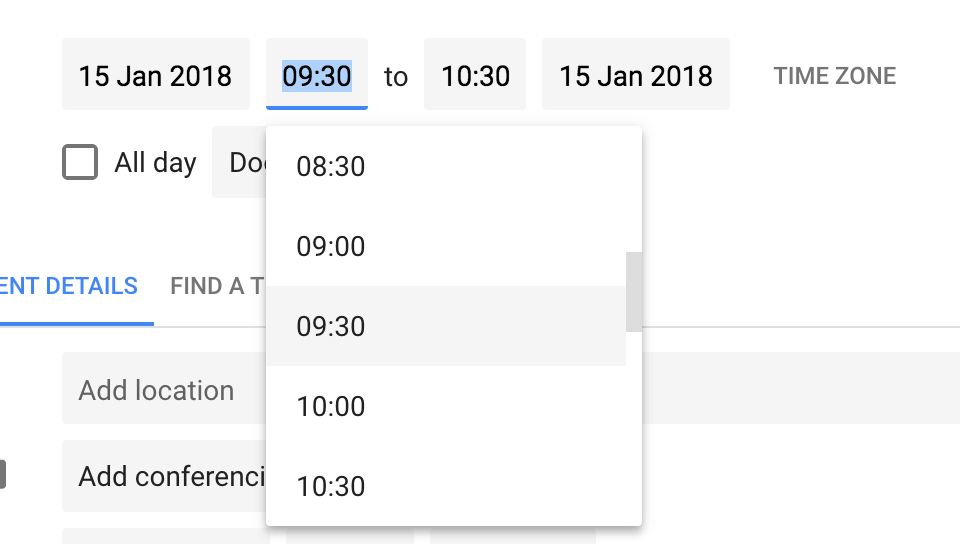Non-Financial and Meeting Incentives to Motivate Your Sales Team

Contents
Companies across the globe share a common problem: meetings. They have too many of them, they last too long, or they include people that don’t really need to be there — or, in many cases, a combination of all three.
Whatever the reason, the fact remains that too many companies are still holding meetings that aren’t as productive or purposeful as they could be.
According to stats reported by Erik Devaney of Drift, the average employee wastes 31 hours a month in unproductive meetings, while the estimated cost of unnecessary meetings to U.S. businesses sits at $37 billion.
Indeed, HubSpot Director Dan Tyre hates meetings. In a recent conversation, he told me: “Meetings are a hangover from the 1980s. They sucked back then, and they’re even worse now.”
It’s hard to argue.
According to stats reported by Erik Devaney of Drift, the average employee wastes 31 hours a month in unproductive meetings, while the estimated cost of unnecessary meetings to U.S. businesses sits at $37 billion.
Of course, this doesn’t mean we shouldn’t have meetings — it just means we need to rethink how we have them. We need to come up with sales meeting ideas that maximize our time and effort.
While the issue spans all industries and departments, sales teams need to be especially aware of wasting time in meetings since time in meetings is time they’re not selling — and that means lost revenue.
Rules for Holding a Productive Sales Meeting
Before we get into sales meeting ideas to keep your sales team motivated and focused, let’s make sure you’ve got the basics right first. Here are some general rules for holding productive meetings (sales or otherwise):
1. Set a Single Goal
Each meeting should revolve around achieving one specific goal. Meetings geared around more than one goal tend to lose focus, so if there are multiple goals on the agenda, seriously consider whether you can leave less-pressing goals for another time.
Can’t think of a goal?
Then you probably shouldn’t be having the meeting.

2. Assign a Leader
All meetings should have someone in charge who’s responsible for ensuring things stay on track.
Designate this person ahead of time – this will allow them time to consider their role in the meeting as they plan for it.
3. Keep Meetings as Short as Possible (and Stick to Your Schedule)
Meetings are typically scheduled in half hour or hour-long slots. I imagine a big reason for this is that, while you can overwrite it, 30 minutes is the default setting in Google Calendar.

While some meetings might require a half an hour or more, many don’t.
A purely motivational meeting might only need 10 minutes, while a brainstorming meeting might take a full hour.
Be realistic about how much time you need, and don’t fall into the classic trap of scheduling meetings in half hour or hour-long blocks, just because Google’s configured that way, and that’s what you’re used to.
In fact, Gary Vaynerchuk advocates scheduling meetings in very short and very precise time slots — as little as 7 or even 5 minutes — and why not? Knowing there’s less than 10 minutes to achieve a goal and that the clock’s ticking is a great motivator. It will also prevent a classic time-waster – dragging meetings out to fill the whole half hour or hour just because your calendar states you should be there for that long.
According to Dan, all his sales meetings are kept to a strict 25-minute time limit. “The last thing you want is somebody droning on about ridiculous stuff nobody cares about,” he said.
Why 25 minutes? “That’s the way we live today. We’re all busy.” And your sales team will thank you for it, as it gives them an extra five minutes to check their emails. If you don’t have 25 minutes’ worth of stuff to get through, Dan suggests either cancelling the meeting or changing it out for a ten-minute meeting.
4. Sales Meeting Agenda
Part of making sure that sales meetings are as productive as possible and don’t waste anyone’s precious time is creating an optimal sales meeting agenda.
Not only do you need your sales meetings to be educational and motivational, but you also want your reps to look forward to the meetings and to enjoy participating in them.
It’s a rare opportunity in the working week to come together for a spot of team bonding – and, according to Dan, a bit of fun.
So don’t underestimate the importance of crafting the perfect meeting agenda, and continue honing it through trial and error over the years.
Your most successful segments will be the parts of the meeting that your reps regularly look forward to, that get them talking.
How can you achieve this?
Dan believes that everything you try to squeeze into your meeting should be impactful. Simply put, cut the fluff.
In our chat, he shared his own sales meeting structure: one that leaves no room for fluff whatsoever.
Welcome and introductions
The welcome and introductions section doesn’t need to be long – in fact, it shouldn’t be – but it should set the tone for the meeting and ensure that everyone feels comfortable.
If there’s anyone new in the meetings Dan asks them three ice-breaker questions. The first two: Who are you? How long have you been at HubSpot? The third question is something a little quirky, such as “What’s your favourite cheese?” or “Where was the last place you traveled to?”
Review from last week
Dan says: “It’s at this point that the team asks themselves: ‘Are there any hanging chads from last week?’”
If so, consider which of them should be rolled over into this week – ensuring continuity is key to making sure that all points are addressed and nothing falls through the cracks.
Pipeline
One of the most impactful parts of the meetings, the Pipeline section is all about ensuring the team is on track to hit its target.
Dan says: “We win as a team, we lose as a team.” This isn’t about shaming anyone. And if the numbers aren’t good, he encourages staff “not to fret about it” and to remember that all organizations have good and bad months.
No more than three things of note
This section of the meeting is about informing the team – but never with more than three points. If there are more than three things to bring up, Dan says, they can’t all be that important and can be rolled over into the next meeting.
Learn a new skill in seven minutes
Next, Dan includes an educational portion in the meeting, where he’s able to help upskill his team. According to Dan, seven minutes is enough to learn a new skill.
FAQs
Dan warns meeting leaders not to let the FAQ section bust their time limit.
“I’m pretty hardcore about my 25 minutes,” he says. “If it’s a great question and timely I’ll say ‘Okay, we’ll take two minutes to answer that now.’ Or I’ll say ‘That’s a great question, let me record a video and send it out to the team.’ Or I’ll say ‘Is that bothering other people? Is that a big deal for everybody?’ If it is, I’ll take the extra five minutes.”
If the question is important yet not timely, Dan recommends rolling it over to the next meeting if the clock is running down.
Motivational ending
This is your moment to ramp up your team to smash their targets.
“Let’s go for it, let’s finish strong,” says Dan. This is all about boosting team motivation, and it’s got to be high energy.
He explains: “It’s like a football team: you go in and you go BOOM!”
5. Focus on the Positive
Save grievances for one-on-one meetings — group meetings should only mention achievements and what went well.
There are rarely any benefits to discussing mistakes publicly. It’s embarrassing for the person (or people) involved, and demotivating for the rest of the team. It also paints the leaders concerned in a poor light, and is likely to (negatively) impact their subordinates’ feelings towards them.
6. Consider Your Remote Workers
Companies with remote workers — whether just one or two or a whole team — have a whole different kettle of fish to fry.
It’s far easier for remote workers to become distracted and zone out from a meeting than it is for workers who are physically present to do the same. It’s also more difficult, if not impossible, to implement some of the concepts included below. 
This means you have to be extra careful when holding meetings that include remote workers. Even more so if your meeting includes both on-site and remote workers (since it’s far too easy for remote workers to feel excluded and become disengaged).
If this applies to you, here are a few things to keep in mind:
- Keeping meetings as short as possible is always important. It’s even more important when remote workers are involved.
- Make sure everyone gets the chance to have their say.
- Treat remote workers as if they’re in the room.
- Ensure all participants speak loudly, clearly, and to everyone – whether they’re in the room or not.
- Invest in quality equipment. Get this bit wrong and your remote workers might as well not be in the meeting at all.
What Are the Advantages and Disadvantages of Virtual Meetings?
While virtual meetings have some drawbacks compared to in-person meetings, they offer some major advantages too. Let’s take a look at the pros and cons of virtual meetings here:
Pros
- Reduced expenses. If you’re not holding face-to-face meetings, you don’t need to hire a meeting room. In fact, if your whole sales team is remote, you might not need an office at all, which equates to big savings.
- Greater participation. People can attend and get involved regardless of where they’re based. And because everyone is attending remotely, the meeting won’t be dominated by people who are in the office.
- No travel. Your sales team can attend meetings in real time without having to endure the commute.
Cons
- Missing body language and social cues. This is a big one. It can be harder to discern what people really mean or how they feel when you’re not in the same room.
- Additional software expenses. If virtual meetings are a key part of your workflow, you likely won’t be able to get by on free (or freemium) product tiers.
- Weak internet connections can affect meeting quality. If someone has bad Wi-Fi, they can’t contribute to the meeting. In fact, they might not be able to attend at all.
Steps to Planning a Virtual Meeting
Any meeting requires preparation. But that’s especially true of virtual meetings; the remote element means you need to go the extra mile to make everyone feel involved and engaged. Here’s how to get it right:
1. Book a time that works for everyone
When your team is remote, there’s always the potential that they’ll be based across multiple time zones. Clearly, you’ll need to take this into account when booking your meeting.
Also, ensure you avoid schedule conflicts. Sales reps work hard on building trust with their prospects, so if they’re expecting an important call or email, that needs to be their priority.
Finally, be strict with the invite list. Does everyone need to be there? If it’s not relevant to your BDRs, don’t waste their time – keep it to SDRs and sales leaders.
2. Share the agenda ahead of time
Setting clear expectations and sharing important documents ahead of time makes it easier for everyone to prepare. In turn, that ensures your meeting will be more efficient, reducing the amount of time you have to spend on basic explanations and other preamble.
3. Pick the right virtual meeting tool
Different conferencing tools have different strengths and weaknesses. For instance, a quarterly sales meeting might work best as a web conference, particularly if multiple people need to speak and share their screens. On the other hand, earnings calls – which aren’t particularly visual – might be best suited to teleconferencing.
Whichever tool you choose, be sure to include links, dial-in numbers, and passcodes in the meeting invite.
4. Rehearse if needed
For more challenging meetings – such as when you’re presenting to the board or a potential client – don’t just assume it’ll be alright on the night. Instead, you should absolutely run a dress rehearsal.
Where multiple people are required to speak and contribute to slide decks, a run-through can help iron out any weak points, avoid repetition, and ensure your content is on point.
What To Do Post Virtual Sales Meeting
The job of running an effective virtual sales meeting doesn’t finish the second everyone hangs up. You still have some important post-meeting tasks to carry out. For instance:
- Share a recording of the meeting for anyone who was unable to attend
- Type up the meeting notes, format them into a logical order, and share them
- Assign follow-up actions through your chosen product management tool
- Ensure anyone who’s been assigned an action understands what’s expected of them
- File all associated documents in the relevant place so they can be accessed by everyone
- Where relevant, schedule the follow-up meeting
Sales Meeting Ideas to Keep Your Team Motivated and Focused
Once you’ve got the basics of running a productive meeting down, you should be ready to diversify the content of your meetings and explore new ways to keep your sales team motivated and focused throughout them.
Just keep in mind that the contents of any meeting – sales or otherwise – will vary according to the attendees and their hierarchy. A meeting between a CEO and CMO would, for example, be very different than a meeting between a CMO and their team of executives. The structure would likely change again if the meeting consisted of a CMO or head of sales and a group of new employees.
Make It Fun
When it comes to the best sales meeting ideas, ensuring they’re fun and enjoyable is key for employee engagement.
Dan reports, “If those guys or women don’t leave the sales meeting totally pumped, thinking you’re pretty funny, then it wasn’t a good meeting. And if you’re not funny, find somebody who can be funny. You have to be impactful, you have to add value, you have to make sure it’s all ready to go. And if you do that you’ll be highly successful.”
To do this, Dan approaches his meetings the way he would a stand-up set. He even “themes” them.
“Have you ever done a sales meeting in your pajamas?” he asks. “You have to have your costumes. Bring your dog to the sales meeting. If you don’t have a dog, get a rental dog.”
“You just want to keep it loose,” he says. “Keep it fun. Give them a little information, but they should stream out of there going, ‘Okay, I’m not going to forget that meeting where everybody had their dog.’ And then you’ve accomplished your goal.”
Share Inside Information
Companies that are transparent have happier and more engaged employees – primarily because being upfront and honest with your employees breeds a culture of trust and openness, and a feeling that you’re all working towards a common goal.
To start embracing a more open and honest culture in your company, make sharing information a regular feature of sales meetings.
Ask Staff to Roleplay
A few days ahead of the meeting, give your staff a theme and ask them to prepare a roleplay based on it. In theory this could be anything, but here are few ideas that make sense in a sales environment: 
- How they overcame a tricky objection.
- The hardest pitch they ever did.
- Their most embarrassing moment as a salesperson.
- How they dealt with an argumentative prospect.
You could actually get more specific with some of these. For example, you might expand that last point to look at things like dealing with a prospect who:
- Thinks they’re more knowledgeable than you in your area of expertise
- Accuses you of lying
- Claims to be interested but will only talk to someone above you
At a minimum, roleplays are usually lots of fun, but they can also be really educational – especially if you encourage more experienced members of staff to act out scenarios that might be new to your less-experienced staff.
Don’t force staff to participate, however — you won’t achieve much by embarrassing your team. That said, roleplays are crazy valuable when it comes to honing sales skills. Anyone who’s not keen on role playing in front of their colleagues should still be roleplaying somewhere a little more private.
“Role-plays are the most under-utilized, as well as the most under-appreciated, sales training tool in the entire sales industry.” Marcus Sheridan, The Sales Lion
Play a Game (with Prizes)
Games that are designed to help your staff work together can help strengthen relationships and boost confidence.
There are countless ideas for team-building games online so I won’t go into much detail now, but here are some quick suggestions for games that I think work well and are easy to organize.
Truth and lies – ask each person to think up two facts about themselves, and one lie. The “facts” are then shared with the group, and the rest of the team is challenged to guess which one’s the lie.
Scavenger hunts – put your team in pairs and give them a list of silly tasks to complete – things like locating a hard-to-find item or taking a selfie with a stranger. For maximum team-building brownie points, make sure you pair up team members who haven’t yet bonded.
The egg drop – split your team up into small groups and challenge them to make a contraption which will house an uncooked egg (something like what you see below) and prevent it from breaking when dropped onto a hard surface.

Hold a (Short) Training Session
Pick one topic and hold a mini training session geared around sharpening your staff’s skills in that area, or teaching a new skill. 
The first time you do this, you’re probably going to want to take on the role of trainer yourself; however, I’d encourage you to open future slots up to your whole team (that said, as with the roleplaying, don’t force anyone to take part — it’s better for everyone if all participants are willing). Incorporating a travel management agency for training sessions into your mini training program ensures efficient coordination of travel logistics, including booking accommodations and transportation. This not only alleviates administrative burdens but also allows participants to focus solely on the learning objectives, maximizing the effectiveness of the training session.
Hold an Impromptu Awards Show
Awards ceremonies are often reserved for the work Christmas party or another annual get-together. That’s fine, but it frequently means that smaller achievements go largely unrecognized.
In addition to an “official” annual ceremony, acknowledge your team’s smaller wins with impromptu awards during one of your regular meetings (complete with rewards, of course).
Surprise Your Staff
Hold your meeting at the end of the day and surprise your staff with a non work-related activity (food and drinks are usually a safe bet — just make sure to consider everyone’s dietary requirements and what non-drinkers/drivers might enjoy). 
This is one of those meetings that you should probably schedule for a half an hour or even an hour. Just make sure to let your team know ahead of time when they should be wrapping up for the day and heading to the meeting room.
Mix Things Up
Avoid following a set agenda. Rinse and repeat, and your team is quickly going to become bored. Even worse, they may well struggle to remember the details of the meeting (it’s a common phenomenon called attentional saturation).
Prevent this by mixing up the format you use, the activities you plan, and the length of meetings.
Here are some of the most popular and effective non-financial sales incentives to consider:
8 Tangible Non-Financial Benefits to Motivate Your Sales Team
When considering which non-financial benefits to present to your sales team, it’s usually the tangible benefits that spring to mind. This is simply because they are what we traditionally think of as benefits, and they remain useful motivational tools.
Here are eight of the best:
1. Vacation Time
Listen up: 96% of all workers say travel incentives are important to them. What’s more, almost three-quarters claim they felt increased loyalty due to travel-based incentives.
Despite this, American companies notoriously offer significantly fewer paid vacation days than those in other countries.
Employees in Brazil, for example, get an average 30 days vacation time per year, while US citizens working in the private sector are granted an average of just ten days of paid vacation after one year of working for a business. And that’s just those who actually get paid vacation days – only 76% of private industry workers do.
Businesses can use this to their advantage by offering workers more of these coveted vacation days – whether to attract top talent or to improve performance.
2. Awards

Awards can be an incredibly cost-effective way to motivate your sales team, but the tricky thing here is legitimizing your awards system. It’s imperative that your sales reps actually want to win.
One way to do this is to run the same awards scheme every month to ensure it gains credibility. This adds a competitive element too – salespeople are by nature competitive and won’t sit back and watch the same person sweep the deck every month.
Consider rewarding the person with the highest win rate, the one who brought in the most revenue, or the one who went the extra mile for a client – or all of the above.
If your budget allows for it, include a prize with the award for an added incentive. This could be a gift card, events tickets, or an experience day. Make sure you outline what the prize is going to be at the beginning of the month so the team knows what they’re striving for.
If there’s no budget for prizes, recognition can be enough on its own. Amplify the news of each month’s winner throughout the company, focusing specifically on senior management. Keep visible records of who won each month in the office – this will keep the awards front of mind.
3. Remote Working Days
Remote working days are a common – and effective – way to reward salespeople.
Consider offering your highest performer of each month a couple of remote working days when they don’t have any face-to-face client meetings. If your setup allows for it, they could even work from a vacation destination on these days (maybe even adding them onto a vacation or a long weekend spent somewhere relaxing).
You’ll up their vacation time without actually losing any team productivity as, on average, employees are 13% more productive when working from home.
4. Recognition from Senior Management
You work with your team day in, day out. And while your praise is essential to your salespeople’s success, it only goes so far.
This is why it’s important to rope in other members of senior management when your team needs additional motivation.
We’ve all seen that flush of pride when a young team member is praised by a director or CEO. Make it your personal mission to make that happen more.
Demonstrating that the most senior members of staff care about the sales team will boost productivity, and it should also boost morale. Who doesn’t want a proud high-five or glowing email from their director?
Action this by sending your sales figures to all senior managers and directors, and encourage them to acknowledge the top performers and rising stars, whether face-to-face, by email, or – best of all – in company meetings.
This approach can be used in conjunction with your monthly awards for even better results.
5. Team Social Events

When it’s the team that you want to reward, rather than a specific individual, there’s no better way than getting everyone together to let their hair down.
Social events are essential for team bonding and building camaraderie. This could be an office party, a swanky dinner, or simply some money left behind the bar at your neighborhood hangout.
That said, it’s important to think about what every member of the team enjoys doing in their spare time, so that no one is left feeling alienated. If most of your team aren’t big drinkers, limit the number of social events you host in a bar setting. If any team members struggle with mobility or physical health issues, make sure events are planned with them in mind.
Set a target for each month – make it super visible in the office – and let the team know what they’ll be treated to for surpassing it. Or even better, let them take it in turns to plan a fun games night, or an afternoon hiking, or an expensive dinner. They deserve it!
6. Leadership Opportunities
There are few better ways to incentivize staff than to offer them opportunities to climb the career ladder. More money, more responsibility, more status – what’s not to like?
Using leadership opportunities as rewards can be tricky, timing-wise, but it’s not impossible. If there aren’t open leadership opportunities within your department when you need them, get creative.
Hand over one or two of your own responsibilities to high performers on the team. This might involve giving them a section of your sales meetings to run, or asking them to train new members of the team.
Just make it clear you’re giving them extra responsibility because you’re impressed with the job they’re doing – and be prepared to give them a pay bump.
Failing to meet either of these two rules may make it seem as if you’re asking them to do more work for the same salary. Far from seeming like a reward for good work, this could have the opposite impact to what you intended. Positioning this type of reward right is everything.
Make sure you emphasize that by taking on more leadership responsibility now, they’re adding to their resume and being primed for the moment a true leadership role opens up. Get them to buy into your vision of their potential as a leader for best results.
7. More Flexibility

Offer your top performers flexibility not afforded to other members of the team. This demonstrates you trust them, while also making their lives a little easier.
For example, you could give them the option to have a remote working day each week – to work nine hours one day and six the next – or the ability to leave an hour early on a Friday, as long as their week’s work is done.
Offering flexibility shows you trust them to do a great job and that you’re willing to reward that trust with greater autonomy. This can be especially impactful for team members with long rush-hour commutes or extended weekend travel plans in mind.
8. Event Tickets
Finally, get your hands on the hottest sports or music tickets available, and then empower your sales team to win them through their achievements.
As noted earlier, it’s important to consider the interests and hobbies of your individual team members when deciding which tickets to go for. To make this work, you’ll need to really get to really know your sales reps. Ask them which upcoming events they’d love to attend, or add a bit of fun to the proceedings by asking them to vote from a shortlist of options.
Unveil which tickets you’ve secured at the beginning of each month, define exactly how your team can win them, and let the competition commence.
7 Intangible Non-financial Benefits to Motivate Your Sales Team
Scanning the list of intangible benefits below, you may think: “I had no idea these actions would incentivize my team!”
The good news is that all of the below actions contribute – both directly and indirectly – to motivating your sales team.
You’ve probably already achieved a number of them – and knowing the motivational effect they can have should motivate you to check off the rest!
1. Communicate and Get Buy-in for Your Vision
Every organization has a vision. But what sets great companies apart is how they include their sales team in that vision. Your salespeople drive the new business and revenue that enable your vision to become reality. Ideally, your vision will also become theirs so you can work toward the same objectives.
Nike is a great example of a company that does this well. Their vision statement, “To bring inspiration and innovation to every athlete in the world,” shows that they’re actually selling a lifestyle, not clothing and shoes.
Whether you’re shopping at a Nike store or on their website, see an ad on TV, or encounter people wearing their clothing, their vision is apparent. It guides everything from their branding strategy to the people and influencers they work with to turn everyone into the athlete they want to be.
You can put this same concept to work for your company. You can’t achieve your vision if you don’t share it. Make your company culture part of the sales process, and ensure it reflects your brand. Sales leaders should build the sales process around the company’s vision to help salespeople see that they’re working toward more than a quota.
2. Make Good Hiring Decisions
The quality of your employees will have an impact on company morale and sales team performance. When sales reps are surrounded by top performers, the standards remain high, the environment stays positive, and each person is invisibly pushed to do their best.
In addition, turnover can eventually force out your best performers. When you’re short on sales reps, others may feel pressured to make up the difference. Not only will your revenue suffer in the process, but visibly struggling to hire good people can send the wrong signal to your current salespeople.
In a case study from Braveheart Sales, one company found that adopting better hiring practices resulted in 122% higher average revenue per rep. And, by the new hires’ fifth month, they were generating 219% more average revenue than those hired in the prior two years.
Fixing turnover issues can be motivating on its own. It lets your seasoned sales reps know you take finding the best candidates seriously, which can also make your team feel more valued since you chose them to be a part of it.
3. Build Trust With Your Team
Trust is the strongest foundation of motivation. When your salespeople trust your guidance, they’re more likely to act on it. However, if they feel you don’t have their best interests at heart, it will be hard for them to feel motivated and inspired by their work. And trust is a lot harder to earn than it is to lose.
As a sales leader, you must be able to trust your team and vice versa. While trust is usually strengthened over time, there are a few things you can do immediately to start fostering mutual trust.
One way to build trust with employees is simply to let them know that you value a trust-based partnership and ask how you can make it happen. Most people respond to this level of transparency and will be happy to share their thoughts. It also shows that you’re interested in working with them, not just acting as their boss.
4. Know Your Team’s Personal and Professional Goals
It’s hard to motivate a team if you don’t know what drives them, and those underlying factors can vary between each person. Invest some time into getting to know each salesperson’s personal motivations and goals, as well as what they want to accomplish in their professional lives.
From there, you can help them set clear paths to those goals. If you’re struggling to open up the conversation, don’t be afraid to be more direct. Ask them outright what motivates them, how they keep themselves focused on their own goals, and how you can help them build confidence and momentum.
Even if you think you know how they’ll respond, don’t assume you know the answer. Your team members may end up surprising you, which helps you get to know them even better. Some reps will feel pressured to answer on the spot, so tell them to take some time to self-reflect and follow up with them about the answers. When you give them time to think, you’ll get more honest, thoughtful answers, rather than just the first thing that pops into their head.
5. Share Success Stories
It’s easy for sales teams to feel like they’re just turning the wheel. Reps usually know where they stand in terms of sales quotas and pipeline deals, but they should also see how their efforts are contributing to the company as a whole.
Put their work into perspective by sharing real client success stories. For example, if they closed a large deal a year ago, take a look back to see how much revenue that client has generated.
Or, you might follow up with some of your biggest clients and get their feedback about their experience so far. Work with marketing or customer service to investigate how your product or service has transformed the client’s business. Marketing can help collect information and compile it into a case study using real data.
As an added bonus, sales reps can use these case studies when selling to prospective clients. Using data from clients they sold in the past adds a layer of reality and personalization to the interaction.
Some companies will leave reviews on your Google My Business or social media accounts and mention employees by name. You can comb through these reviews and share some positive client experiences with your sales team to show that clients really do care about the quality of service they’re providing.
The salesperson’s main job is to sell, but what they’re selling is valuable to your clients. You might be helping clients grow their own bottom lines or solve a specific business problem. Whatever the case, the sales rep has played an important role in every client they’ve closed, so put this into perspective so they know they’re doing more than just driving revenue.
6. Let Team Members Choose Their Own Reward
Your team members have the best insight into what drives them, so it makes sense to let them choose their own reward for a job well done. Plus, it takes some of the pressure off you since you don’t have to come up with motivation strategies that will please everyone.
A fun way to do this is through gamification, which applies the typical elements of game play to organizational activities. For example, sales reps might score points for every opportunity they create or every deal they close.
Companies that have experimented with gamification say it’s highly effective in motivating team members. A case study from MotivAction details how one bank used gamification to improve their results when only a quarter of their financial advisors were meeting their sales goals. They used a sales reward platform to provide non-cash incentives based on performance, so each participant was in control of what they earned.
The program achieved 200% of its goal and 95% of the bank’s annual sales revenue in the first quarter alone.
This concept has both intrinsic and extrinsic qualities. On the extrinsic side, employees were working toward an arbitrary quota set by someone else with the promise of a reward or compensation at the end. But on the intrinsic side, employees were also empowered to choose their own reward. They could assume responsibility for setting their own goals beyond what the company required in order to get a specific prize.
Since everyone is motivated in different ways, it makes sense to give them control over their own payout.
7. Always Let Your Team Know Where They Stand
Most sales organizations use annual reviews to go through an employee’s performance, but that shouldn’t be their only touchpoint. Nearly 45% of HR professionals believe that annual reviews aren’t an accurate depiction of an employee’s performance.
Your sales team likely agrees. More than 96% of employees say they prefer to receive regular feedback and that annual reviews aren’t enough. Team members should always know where they stand and the progress they’re making so they can better direct their efforts.
Companies that go above and beyond the annual review see an 8.9% increase in profitability and a 14.9% reduction in employee turnover compared to companies that give no employee feedback. Employees want to know if they’re doing a good job, and expect management to provide ongoing feedback.
However, it’s not enough to focus on the positives. Everyone has something they can improve or work toward, and employees expect management to take the lead when providing feedback.
To start, you can help your team set daily, weekly, monthly, and yearly goals for their performance. If their sales are suffering, help them achieve small wins to keep them moving forward every day. This helps to take the pressure off them so they can feel positive and encouraged to do better, rather than feel like they’re spinning their wheels and will never be as great as the reps around them.
Also, you can share wins with the team and let them know how they’re making progress as a group. Ask each sales rep to write down everything positive that happens to them that day, then circle up later and have them share their experiences. For example, they might receive a compliment from a client, or maybe they finally got a response from someone they’ve been chasing for a month. This adds a tangible factor to the experience and proves that good things are happening, even when it feels like they’re getting nowhere.





